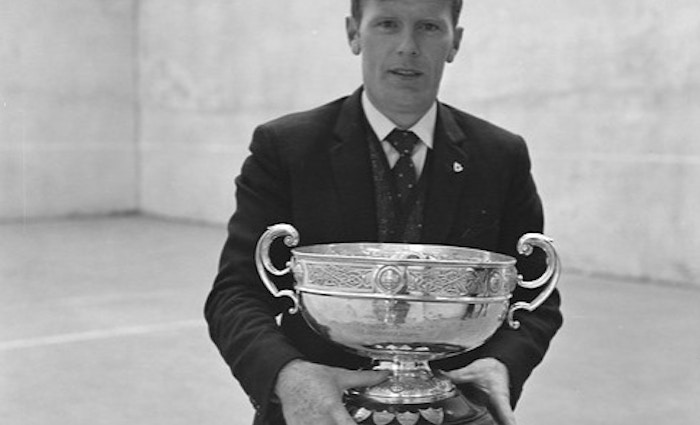
This December will mark 70 years since the inauguration of one of the most storied and successful competitions the sport of handball has seen, writes Paul Fitzpatrick.
The Gael Linn competition served off that year and grew from relatively humble beginnings (160 players nationwide entered in year one) to a mammoth tournament which, at its peak, had almost 1300 entries.
It may seem alien to younger handballers now given the prevalence of competitions and All-Ireland grades, but there was a time when very few national medals were handed out and players of varying abilities were willing to take their chance against the best around.
Gael Linn, a football pool which provided funds for the Irish language, came on board and donated a beautiful cup for the new competition, presenting it to the Irish Handball Council in November of 1953.
The format was novel and it captured the imagination. At a selected venue in each handball area (which at the time was most of the country) players contested the regional competition. When the regional champions were declared, the competition continued on a national level. Crucially, it was played on a 30-minute timed basis, which was highly innovative and differed from the normal scoring system.
It originally took place on each of the seven Sundays from the first Sunday in December onwards, although this was later tweaked. Great excitement greeted the new competition, with the Connacht Tribune reporting that “It is expected that the game will benefit greatly as a result of the competition as it will take place at a time when competitive handball is ordinarily at a standstill”.
The opening round of fixtures took place on December 6, 1953 at Bray, Crumlin, Fermoy, Cong, Ballymote, Clones, Birr, Fahy Cross, Limerick, Hospital, Talbot’s Inch, Tuamgraney, Ballina (Tipperary, where brothers Anthony and Connie Collins met), Tralee, Pomeroy, Loughmacrory, Athlone, Multyfarnham, Ballyanne, Clogherhead (the legendary Joey Maher beat Sean Butterly from Dunleer in this match) and St Malachy’s College, Belfast.
The games were well covered by the national and provincial press, with the Nenagh Guardian reporting on the Ballina game that “with the winning of the tie, Connie completed a unique double – he won £18 in the Limerick Dominican Church draw earlier in the week.”
Collins went all the way to the final, where he lost to the first champion, Wexford’s John Ryan.
Almost immediately, the Gael Linn caught on and entry numbers swelled as players from all grades vied to progress in their own region and make the final stages.
In year two, there were 240 entries and by 1956, 304 players took their chance. The annual national handball report to convention stated that this had “exceeded all expectations”.
The Cuchulainn Annual in 1961 wrote, “A sign of the enthusiasm engendered by the Gael Linn Cup was the record-breaking entry of 856. This showed an increase of 112 on 1960.”
In the 1960s, the competition was huge, regarded as close in prestige to an All-Ireland (this in the days when there were less than 1% of the All-Ireland titles now on offer).
By the end of that decade, 1,048 entries were recorded (400 from Leinster, 248 Connacht, 232 Munster, 168 Ulster).
The entry in 1970 was the second highest on record but it declined the following year, with the annual report commenting that “the only possible explanation for this decline is that the clubs now have a wider variety of competition and tournaments”.
However, it bounced back and there was a record entry of 1168 in 1973. Three years later, numbers fell to a still very healthy 920, the annual report putting forward the increase in the entry fee and the “variety of competition now available to novice and junior players” as possible reasons.
By the late 1970s, popularity was waning, even though (or perhaps because) a 40x20 section was added. The finals were by then played on the same weekend as National Congress at Croke Park.

A preponderance of competitions had been added at this stage and were vying for space on the Clár, with 40x20 handball taking off. The powers that be felt that something had to give and it was decided the Gael Linn should be shelved.
The 1980 annual report stated: “As a result of the decision of Annual Congress, it was agreed to ask for submissions on the format of a suitable competition to replace the Gael Linn Competition. However, no proposals were received and the position now is that the Gael Linn trophy is still in our possession and unless a suitable competition is found, the very valuable cup will have to be returned to Gael Linn.”
As it turned out, handball kept this magnificent cup. A mixed boys and girls juvenile doubles competition for younger children was begun, bearing the Gael Linn name, and still survives but thankfully the precious cup was given a new lease of life some years back when it was repurposed to be used for the All-Ireland 40x20 Senior Singles Championship.
Seventy years on, handball has moved to a different model, with hundreds of champions crowned each year. The Gael Linn Championship is long gone and with it went the tradition of a national open draw competition in which the best emerged over several gruelling rounds and new players were willing to ‘play up’ and take on the best around – but for those of a certain generation, the memories of great players like Maher, Lyng, Confrey, Ryan and Kirby among other legends still remain.
Main pic: Dick Lyng from Wexford with the Gael Linn cup in Falcarragh, Co Donegal, Easter Sunday, 1971.
Second pic: A photo taken at Baylor’s Alley, Fermoy around 1954 at a Gael Linn area final. Included in the photo are (back, from left), Paddy McGrath, Jim O’Mahony, Mick Griffin, Unknown, Unknown, Murty McEllistrim. Front: Robert McGrath, Paddy Hickey, Ned O’Gorman. Robert McGrath won this area final.
